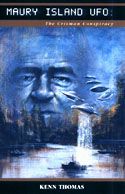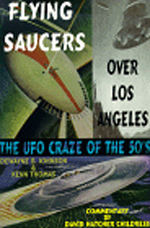 Offline Illumination
Offline Illumination Offline Illumination
Offline Illumination


Nicholas Redfern began building a respectable reputation as a documentary historian on UFOs with his first effort, A Covert Agenda: The British Government's UFO Top Secrets Exposed , struggling with the UK's thirty year rule and wrenching many important documents from the British Ministry of Defense. He expanded his role as document liberator to the US with his second book, The FBI Files: The FBI's UFO Top Secrets Exposed. He also has made important contributions to the work of another great UK ufologist, Timothy Good (Above Top Secret). Redfern's new book, Cosmic Crashes: The Incredible Story of the UFOs That Fell To Earth (Not yet listed at amazon, but available from Simon & Schuster UK Ltd, Africa House, 64-78 Kingsway, London WC2B 6AH), continues in this vein, with up close examination of previously classified documentation concerning crash retrieval incidents, at the RAF station at Cosford in December 1963; at Penkridge, Straffordshire the following year, in the Berwyn Mountains, North Wales, and many others. Almost as remarkable as these UFO events, however, are Redfern's adventures into the Public Record Office, with Freedom of Information Act recovery, and among witnesses to establish what is actually documented about these incidents. Redfern focuses on the documents, most of them firmly official. When he speculates, the speculation grows logically from the documentation. Cosmic Crashes is quite meticulous in this regard.
In some cases, he must speculate about the document itself. Such was the case with the Speriglio document, originating not from FOIPA but with the author of The Marilyn Conspiracy and Crypt 33: The Saga of Marilyn Monroe. The Speriglio document holds forth that newspaper columnist Dorothy Kilgallen received word that JFK took Marilyn Monroe to a desert base "for the purpose of inspecting things from outer space." Redfern identifies Speriglio as a "court-certified questioned-document expert", but fortunately does much more than that in attempting to establish the authenticity of the document, since court certification in the US is next to meaningless. (Courts certify as experts anyone lawyers present as experts.) Redfern contextualizes the Speriglio document with a FOIPA request that yielded "a mountain of once classified FBI documents on both Kilgallen and Monroe." No smoking gun emerges from the collection, but Redfern establishes clearly that Kilgallen "was not someone to whom the acquisition of sensitive material was a rare event." The files released to Redfern reflect that Kilgallen acted as a source of foreign intelligence information for the CIA and in return likely was rewarded with UFO information from in the mid-1950s.

That same give-and-take relationship may have also existed between the intelligence community and Fred Crisman, subject of the soon-to-be released Steamshovel-related book, Maury Island UFO (IllumiNet). Although Redfern does not mention the Maury Island case in his new book, he did interview Steamshovel editor Kenn Thomas, along with Greg Bishop of the Excluded Middle, on the subject in August 1998, as both books were under development. Below is a transcript of relevant parts of that interview.
Nicholas Redfern: I'm really interested in this story that Kilgallen was telling about a crashed UFO incident in Great Britain during the Second World War. She reported it in '55 and it actually made British press. Supposedly she was told about it at a cocktail party in England. The problem, if you like, is as I began to look into this crash, it sort of spread its web out into all different areas as well. It came to everything from Marilyn Monroe, her association with Kilgallen and JFK and from there, obviously, the JFK things spreads out to Crisman and people like that. So may I just throw you a few names and situations and so forth and just ask you your comments?
Kenn Thomas: Sure.
Redfern: May we start with Maury Island, as to what Maury Island is?
Thomas: Well, the Maury Island incident is, of course, the subject of the book that I am working on, the research from which this current book that I have, Flying Saucers Over Los Angeles, grows out of. It's basically the first modern UFO incident. The story of UFOs is that mankind has been encountering them throughout its history, but the post-1947 wave is considered the first modern wave. It's usually considered as beginning with Kenneth Arnold's sightings over Mt. Ranier, but this sighting, the Maury Island incident, actually took place three days before that happened. One interesting dimension of this debate in a recent "skeptics" magazine was argued recently by Robert Scheaffer that flying saucers never existed because Kenneth Arnold never saw a flying saucer. This is only half-true. Arnold saw chevron shapes and he said that they flew as a saucer would if you skipped it across water,. A press reporter picked that up and coined the term "flying saucers" and according to this so-called "skeptical" writer, people picked up that term in the press and started reporting flying saucers. This new book, Flying Saucers Over Los Angeles, out now totally disproves this. You can see in the new reports that there are flying triangles, flying candles, flying bananas, the whole wide variety of UFO experiences.

At Maury Island they were saucers. This is in Tacoma, Washington, in Puget Sound. These guys were patrolling the harbor. Even that is an awkward description. They weren't harbor patrolman. They were not official police authorities. They just scoured the bay there to get driftwood and logs for resale.
Redfern: They were unemployed.
Thomas: Actually, you can't really say for certain. All we know is that one of them, Harold Dahl, considered the other, Fred Crisman, his boss. I guess Crisman was running the operation. So Dahl considered himself working for Crisman, although the ship, the boat, is registered to Dahl!
Redfern: He was working the harbor.
Thomas: He was working the harbor with his son, some other guys and they had a dog with them. Crisman wasn't there. They saw six saucer-shaped things. Actually, doughnut shaped things. They had a bulge in the middle. And one spewed some kind of stuff out that actually killed the dog and injured the son, according to the story. They took off and Dahl took some of the slag and reported back to his "boss", Fred Crisman, that this has happened. Crisman then, the next day, went out, collected some more of the slag and then he saw one of them, but it didn't have the bulge in the middle.
That was it, for the most part. Kenneth Arnold had his sighting, became famous for it immediately, and after he accrued a certain amount of fame, he was hired by Ray Palmer, who published these science fiction pulp magazines.
Greg Bishop: He had one called Flying Saucers, actually.
Thomas: Yeah. In fact, the imagery if not the actual term "flying saucers" probably predated all this business that the term came after Kenneth Arnold, is probably not true.
Palmer hired Kenneth Arnold to investigate Crisman and Dahl. He gave him $200 and said fly up there and go talk to these guys. He did this at the Hotel Winthrop, in Room 502, at the time he also picked up E. J. Smith, a United Airlines pilot who had his own sightings. He had an interesting history himself. He heard about Arnold's sighting and made some public statement about how Arnold must be crazy. Then he had his own sighting and retracted what he said about Arnold. Both of them visited with Crisman and Dahl, took down their stories, and freaked out. They didn't know what to make of it to the extent that Arnold called his Air Force intelligence buddies, people who had talked to him after his initial report. Lieutenants Brown and Davidson, who came out and took statements from Crisman and Dahl, apparently took a Kelloggs Cornflake box filled with the slag, loaded it up on a B29 and were taking it back with them to McChord Air Force base.
They were going back for the first observance of the Air Force's independence from the Army. It's still observed. In fact, last year there was a videotape circulating of Monica Lewinsky with this Pentagon brass, the point being that she had somehow gotten access, hanging out with important Pentagon people, observing that very anniversary. But Davidson and Brown never made it back. They crashed. They died, The slag was never recovered.
Redfern: Do you know what Arnold's conclusion was about Dahl and Crisman?
Thomas: I don't think he reached a firm conclusion. I think he found himself in a situation where—there were just so many things that were strange about what had happened to him in Room 502. They were being spied upon. In fact, the Flying Saucers Over Los Angeles, prints a dissertation by a friend of Ted Morello, who was the United Press bureau chief at the time, who was spying on them, calling them up, trying to get information. It's interesting: he talks about how paranoid Arnold is and in almost the very next sentence he talks about how he's converted his intercom system to a microphone, and secretly recorded a conversation with Arnold.
… Thomas: I have a tape of the last week of What's My Line, the old TV show that Dorothy Killgallen appeared on, including the program from the day she died, three hours after the broadcast. When she died there was an electrical black out of the eastern seaboard and a lot of UFO sightings.
Redfern: In the same week?
Thomas: Yeah, right after she died. The night she died.
Bishop: The Niagara Falls power plant.
Thomas: Really?
Bishop: Yeah, Scott Corrales wrote about that in the last issue of Excluded Middle.
Redfern: What is the consensus, if there is one, with regard to Kilgallen's death?
Thomas: There's only one book on Kilgallen, although she wrote a couple of books, by Lee Israel, called Killgallen. The conventional view is that she died of an overdose, an accidental overdose of pills.
Bishop: She was an alcoholic and did a lot of pills, which will kill anybody as well. It just happened to be right after she uncovered this—I thought it was something to do with a Swedish or Finnish UFO crash retrieval…
Redfern: That's what I'm mainly interested in with the Kilgallen thing.
Bishop: British intelligence had found out something about one of the Scandinavian countries.
Redfern: There was one on the island of Spitzbergen.
Thomas: But that was years before.
Redfern: Yes, it was ten years before. She was told in the mid-50s about this alleged crash in Britain. The British were supposedly somehow involved in this one in Spitzbergen So there seems to be a tie-in somewhere.
Thomas: The reason the Speriglio document appears in my book Mind Control Oswald & JFK is that Kilgallen wrote a column in 1964 that says "Memo to Lyndon Johnson: The Army has been perfecting a mind control technology called 'cloudbusting," which is a direct reference to Wilhelm Reich. He created this cloudbusting cannons using orgone energy, and he took them out to the Tucson desert and fought UFOs.
Redfern: Do you know more about the relationship between Monroe and Kilgallen? Was it purely because she was in the entertainment field?
Thomas: As far as I know, that was it. They were just friends. They were both pill junkies, I guess.
Bishop: [laughter]
Previous Offline Illumination